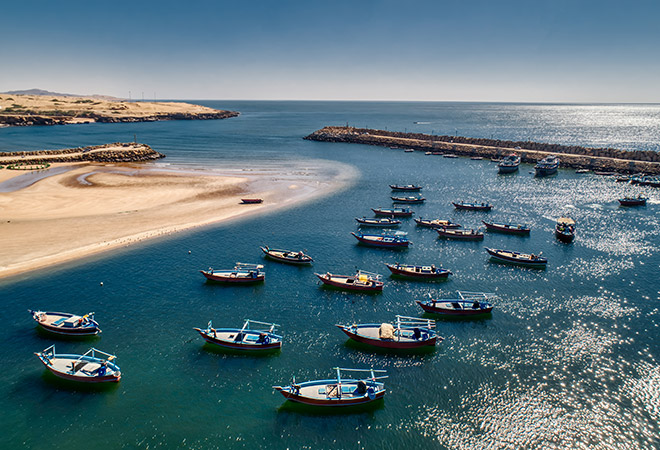
The Chabahar-Zahedan railway link construction moving ahead without India’s involvement will not, on its own, derail India’s investment in Chabahar. Read against ongoing developments — Iran also going ahead with developing the Farzad-B gas block without India; the China-Iran economic and security partnership currently being finalised — and the tea leaves suggest a different picture. When set against continuing US sanctions on Iran and Chinese moves in the broader region, an element of urgency emerges.
India’s ‘coup’ with Chabahar as a preferred development partner spelled particular optimism for a credible outreach, finally, to Afghanistan and onward to Central Asia. It also meant, finally, the potential to circumvent perceived Chinese encirclement as it developed the Gwadar port, and then CPEC, on India’s western flank.
But there continues to be an active conversation on the role and strength of Chabahar in India’s calculus. In light of ongoing and recent developments, what are key costs for India as it seeks to pursue these above-stated objectives?
The road and railway to Afghanistan
Immediately, a first set of costs arises for India’s access to Afghanistan.
A recent report stated that Iran would be, without Indian help, continuing with the construction of a railway link from the southeastern Chabahar port to Zahedan, near the Afghan border, citing funding delays by New Delhi. Days after the report appeared, Iran denied the claim that India had been dropped from the project, stating that it had never “inked any deal with India regarding the Zahedan-Chabahar” railway in the first place. It later added that “the doors were still open for India” to join the project at a later date. This raises the question of whether India and Iran are on the same page. Is this another episode in Iran’s playbook to play potential investors against each other, or does it betray a deeper, festering malaise in the bilateral relationship due to a perception of India being under Washington’s thumb?
If Chabahar is seen as the fulcrum for India’s outreach to Afghanistan (and Central Asia), then it is India’s long-standing ties with Iran that should be the lever allowing its connectivity ‘machinery’ to work, not a simple railroad link.
Pulling back, the current political situation in Afghanistan — including but not limited to, the forthcoming negotiations between Kabul and the Taliban; the foreseeable withdrawal of US troops from the country and the continuing violence — along with international sanctions on Iran have already been problematic for India to navigate. The waiver India was able to negotiate allows it to continue developing Chabahar and pursue ties with Afghanistan. But between bilateral see-saws, at stake for New Delhi are the questions of a) continued and b) degree of access to Afghanistan. If Chabahar is seen as the fulcrum for India’s outreach to Afghanistan (and Central Asia), then it is India’s long-standing ties with Iran that should be the lever allowing its connectivity ‘machinery’ to work, not a simple railroad link.
The 2016 landmark trilateral agreement between India, Iran, and Afghanistan brought together the three countries as natural partners to seamlessly develop and strengthen trade complementarities (and which critically reduced dependence on Pakistan). India’s engagement on the ground, however, has proceeded in fits and starts. Budget allocations and disbursements, ongoing operational hurdles, and the international environment have all tended to spark another round of debate on the role and place of Chabahar in India’s strategic vision as progress remains slow and difficult. A key project has been linking Chabahar, via railroad, to the 215km-long Zaranj-Delaram highway in Afghanistan that India has already built, which Iran is now proceeding to do on its own. India and Afghanistan have been sending exports through the port since 2019, with goods travelling via truck from the port to the Afghan border. Last year, over $1 billion in Afghan goods were exported from the port, with the potential for that number to double by the end of this year.
What works in India’s favour is its unique positioning in the region.
Critically, any limitations to India’s use of ground networks between Iran and Afghanistan, regardless of who builds them, will leave it only with the India-Afghanistan air freight corridor established in 2017. While the air route has provided Afghanistan greater access to Indian markets and allowed Afghan businessmen to leverage Indian trade networks for their benefit — to the extent that Kabul is investing in an expansion of its air corridor programme with five other countries — the limitations for India are obvious, as notes one observer, “in terms of not just trade and economic assistance but also military assistance.”
What works in India’s favour is its unique positioning in the region. Its close relationship with the US and Israel make it an unusual ally to Iran, but also an ideal actor to oversee a sustainable economic partnership between Kabul and Tehran. Even as Iran considers developing a closer economic and strategic partnership with China, it must realise the advantage of working with New Delhi, its only partner that enjoys a sanctions waiver from the US for Chabahar and which has an aversion to a Taliban takeover in Afghanistan.
On its end, India’s infrastructure-building commitments must reflect resolve and urgency so that it can carve itself as a regional stakeholder, and a reliable partner for Iran and Afghanistan. Repeated instances of a disjointed India-Iran bilateral, whether due to operational and bureaucratic glitches, or in the context of US and China, will inevitably result in reduced Indian presence, influence, and leverage at Chabahar that will first and foremost pose costs to its relationship with Afghanistan.
Connecting the dots in the region
A second, longer-term cost to India regards its leadership in regional connectivity.
Iran has stood at the crossroads of the Silk Road Economic Belt — the overland tranche of China’s Belt and Road Initiative (BRI) — and the Indian-backed International North-South Transport Corridor (INSTC), with Gwadar and Chabahar the most visibly representative competing poles of approach and presence in the Arabian Sea. Deteriorating US-Iran ties have slammed the door largely shut on the promise of the INSTC. Periodic agreements and MOUs to explore logistics potential and efficiency gains have failed to amplify Indian involvement in the multi-modal corridor, even as Iran, Russia, Azerbaijan, and other stakeholders strive to build and make stretches of the route attractive for localised demand and supply. Sanctions have crippled once-heady visions of expanding participation in the INSTC to international heavyweights, such as Japan and South Korea; even at Chabahar, which received an exemption on humanitarian grounds, supplies have been hard to come by.
Iran has stood at the crossroads of the Silk Road Economic Belt — the overland tranche of China’s Belt and Road Initiative (BRI) — and the Indian-backed International North-South Transport Corridor (INSTC), with Gwadar and Chabahar the most visibly representative competing poles of approach and presence in the Arabian Sea.
Meanwhile, China is expanding its footprint in the region as it strengthens ties with Iran, Saudi Arabia, UAE, Egypt and other MENA countries. While a cautious newcomer, it is increasingly more relevant as a key investor, trading partner and source of tourism for countries in the Middle East. Importantly, even as BRI sees hurdles in other parts of the world, a convergence of interest has led to relatively greater receptivity from China’s MENA partners. As of mid-2019, 21 MENA countries had signed BRI contracts; Chinese firms have almost doubled their work in the region from 2007-2012 to 2013 onwards; and Arab states have already begun using China’s BeiDou Satellite Navigation System. Infrastructure development — stadiums, railways, industrial parks, 5G highways, clean energy projects — are a concrete testament to Chinese engagement under an expanding BRI umbrella. This overland groundwork is coupled with China’s maritime port-industrial park complexes that dot the Middle Eastern rim. Between and beyond Djibouti and Gwadar lie the likes of UAE’s Khalifa port and KIZAD Logistics Park; Egypt’s Port Said and TEDA-Suez Zone; Oman’s Duqm port and industrial park; and Saudi Arabia’s Jizan port and Economic City.
The 25-year, $400 billion agreement being finalised between China and Iran includes allocations in Iran’s transport and manufacturing sector, as well as hydrocarbon industries, with Chinese companies, equipment, and workers being given right of way. China has not stepped in to fund the Chabahar-Zahedan railway link, and actual disbursements of Chinese finance may never reach promised sums — not to mention some skepticism and project delays (China’s current investment in Oman’s Duqm port, for instance, is far from the $10 billion originally pledged). Whether Chinese firms agree to expose themselves to US sanctions also remains to be seen. Yet, China’s continued, relative, and even symbolic progress vis-a-vis India’s much slower pace — characterised by one academic as New Delhi’s “risk-avoidance diplomacy” — leaves large room for Iran to eventually become another principal “production node” in China’s BRI that is seeing momentum in the Middle East.
Will China’s primacy in Iran’s production and consumption networks limit the potential of India’s access to Central Asia, Russia, and Europe through Chabahar as the east-west movement of goods and investment is prioritised? India’s competitiveness will definitely suffer the more its engagement at Chabahar remains restricted and the more the INSTC becomes a collection of localised multi-modal connections. In question then are India’s levers of engagement in its extended neighbourhood to the west, and its reputation and projection as a credible economic and development partner (to the tune of becoming an ineffective player caught between the US and China). Furthermore, if a re-reading of history sees a Chinese push in Iran as Beijing’s raise to New Delhi’s ante of reviewing Chinese investments and temporarily banning a number of Chinese apps, itself in response to the recent border clash, it could cement the idea of hitting interests in third countries as another line of attack in response to bilateral conflicts. Chinese actions on this front would not bode immediately well for India’s regional connectivity plans.
A re-reading of history may see this episode cement the idea of hitting interests in third countries as another line of attack in response to bilateral conflicts. Chinese actions on this front would not bode immediately well for India’s regional connectivity plans.
Equally pressing is China’s expanding presence in the Arabian Sea and the Red Sea. Even as Chabahar has never been India’s to lose in the first place, its participation in the Arabian Sea port broke perceived China’s maritime encirclement. If China pursues investments at Chabahar, whether as part of this deal or otherwise, paving the way for Gwadar and Chabahar to become “sister ports,” it will aggravate India’s security calculus in the immediate Western Indian Ocean — both for itself and for any connectivity projects it develops as a runner-up to China. Not to forget here is the probability of greater Chinese security presence shadowing its growing economic footprint in this region, hastened by big-ticket BRI projects. To wit: an expanding presence of Chinese submarines in the Indian Ocean; the 2019 joint naval exercise between China, Iran, and Russia; the burgeoning China-Pakistan security relationship.
Bilateral equations will continue to play out in the region — whether Iran’s diplomacy towards China even as it seeks to keep an eye cocked west; whether Arab states’ hedging between US and China; whether India’s ties with Iran as it strengthens its relationship with the US. In view of the immediate and longer-term costs to Indian interests vis-a-vis Afghanistan and signaling as a regional stakeholder and partner, however, day to day changes in bilateral ties cannot — should not — be what propel forward India’s policy options at Chabahar, year by year, decade by decade.
The views expressed above belong to the author(s). ORF research and analyses now available on Telegram! Click here to access our curated content — blogs, longforms and interviews.




 PREV
PREV



